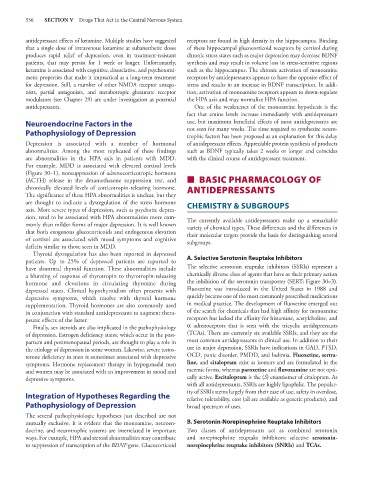Page 550 - Basic _ Clinical Pharmacology ( PDFDrive )
P. 550
536 SECTION V Drugs That Act in the Central Nervous System
antidepressant effects of ketamine. Multiple studies have suggested receptors are found in high density in the hippocampus. Binding
that a single dose of intravenous ketamine at subanesthetic doses of these hippocampal glucocorticoid receptors by cortisol during
produces rapid relief of depression, even in treatment-resistant chronic stress states such as major depression may decrease BDNF
patients, that may persist for 1 week or longer. Unfortunately, synthesis and may result in volume loss in stress-sensitive regions
ketamine is associated with cognitive, dissociative, and psychotomi- such as the hippocampus. The chronic activation of monoamine
metic properties that make it impractical as a long-term treatment receptors by antidepressants appears to have the opposite effect of
for depression. Still, a number of other NMDA receptor antago- stress and results in an increase in BDNF transcription. In addi-
nists, partial antagonists, and metabotropic glutamate receptor tion, activation of monoamine receptors appears to down-regulate
modulators (see Chapter 29) are under investigation as potential the HPA axis and may normalize HPA function.
antidepressants. One of the weaknesses of the monoamine hypothesis is the
fact that amine levels increase immediately with antidepressant
Neuroendocrine Factors in the use, but maximum beneficial effects of most antidepressants are
Pathophysiology of Depression not seen for many weeks. The time required to synthesize neuro-
trophic factors has been proposed as an explanation for this delay
Depression is associated with a number of hormonal of antidepressant effects. Appreciable protein synthesis of products
abnormalities. Among the most replicated of these findings such as BDNF typically takes 2 weeks or longer and coincides
are abnormalities in the HPA axis in patients with MDD. with the clinical course of antidepressant treatment.
For example, MDD is associated with elevated cortisol levels
(Figure 30–1), nonsuppression of adrenocorticotropic hormone
(ACTH) release in the dexamethasone suppression test, and ■ BASIC PHARMACOLOGY OF
chronically elevated levels of corticotropin-releasing hormone. ANTIDEPRESSANTS
The significance of these HPA abnormalities is unclear, but they
are thought to indicate a dysregulation of the stress hormone CHEMISTRY & SUBGROUPS
axis. More severe types of depression, such as psychotic depres-
sion, tend to be associated with HPA abnormalities more com- The currently available antidepressants make up a remarkable
monly than milder forms of major depression. It is well known variety of chemical types. These differences and the differences in
that both exogenous glucocorticoids and endogenous elevation their molecular targets provide the basis for distinguishing several
of cortisol are associated with mood symptoms and cognitive subgroups.
deficits similar to those seen in MDD.
Thyroid dysregulation has also been reported in depressed
patients. Up to 25% of depressed patients are reported to A. Selective Serotonin Reuptake Inhibitors
have abnormal thyroid function. These abnormalities include The selective serotonin reuptake inhibitors (SSRIs) represent a
a blunting of response of thyrotropin to thyrotropin-releasing chemically diverse class of agents that have as their primary action
hormone and elevations in circulating thyroxine during the inhibition of the serotonin transporter (SERT; Figure 30–3).
depressed states. Clinical hypothyroidism often presents with Fluoxetine was introduced in the United States in 1988 and
depressive symptoms, which resolve with thyroid hormone quickly became one of the most commonly prescribed medications
supplementation. Thyroid hormones are also commonly used in medical practice. The development of fluoxetine emerged out
in conjunction with standard antidepressants to augment thera- of the search for chemicals that had high affinity for monoamine
peutic effects of the latter. receptors but lacked the affinity for histamine, acetylcholine, and
Finally, sex steroids are also implicated in the pathophysiology α adrenoceptors that is seen with the tricyclic antidepressants
of depression. Estrogen deficiency states, which occur in the post- (TCAs). There are currently six available SSRIs, and they are the
partum and postmenopausal periods, are thought to play a role in most common antidepressants in clinical use. In addition to their
the etiology of depression in some women. Likewise, severe testos- use in major depression, SSRIs have indications in GAD, PTSD,
terone deficiency in men is sometimes associated with depressive OCD, panic disorder, PMDD, and bulimia. Fluoxetine, sertra-
symptoms. Hormone replacement therapy in hypogonadal men line, and citalopram exist as isomers and are formulated in the
and women may be associated with an improvement in mood and racemic forms, whereas paroxetine and fluvoxamine are not opti-
depressive symptoms. cally active. Escitalopram is the (S) enantiomer of citalopram. As
with all antidepressants, SSRIs are highly lipophilic. The popular-
Integration of Hypotheses Regarding the ity of SSRIs stems largely from their ease of use, safety in overdose,
relative tolerability, cost (all are available as generic products), and
Pathophysiology of Depression broad spectrum of uses.
The several pathophysiologic hypotheses just described are not
mutually exclusive. It is evident that the monoamine, neuroen- B. Serotonin-Norepinephrine Reuptake Inhibitors
docrine, and neurotrophic systems are interrelated in important Two classes of antidepressants act as combined serotonin
ways. For example, HPA and steroid abnormalities may contribute and norepinephrine reuptake inhibitors: selective serotonin-
to suppression of transcription of the BDNF gene. Glucocorticoid norepinephrine reuptake inhibitors (SNRIs) and TCAs.

